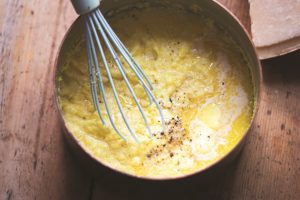I have a pile of dog-eared seed catalogs marked with checks and circles — a paper hope chest filled with my garden aspirations. They sit in a growing pile on the coffee table, promising longer, warmer days.
From my kitchen window I see six stalwart kale plants poking up through the snow. But in my mind’s eye I imagine beds of fresh mulch cradling bright green sprouts of just about everything. A guy wants to grow things now, snow cover be damned!
Since I have neither a greenhouse nor a cold frame, I decided to scratch my itch to farm with mushrooms, inspired by an article about a New York City mushroom farm that, for a fee, would send me a self-contained mushroom garden by mail.
I had considered growing mushrooms before; last summer, I had a number of chats with Uli Winslow, Truro’s fabled mushroom guy. I bought his freshly harvested mushrooms at the farmers market — with a particularly memorable tart of mushrooms and leeks as one result. But I never got around to ordering the mycelium-inoculated logs he offered. According to his instructions, all I had to do was give the log a good soak and soon I would be harvesting. I got stalled imagining how I would explain to Christopher that the log on our counter was there to provide us with supper.
The kit came all the way from Brooklyn. There would be no tree branch on the counter, just a plastic-wrapped growing medium with instructions on its three-times-a-day spritzing needs. I am also asked to name the garden. I decided on Chenille. My car is named Rosie and my vacuum is named Trixie, so it didn’t seem at all out of character to pick a name for the garden, which now sports a blue “Hello, my name is Chenille” tag.

Just two days after her first spritz, mushroom “pins” started to appear. From there, the mushrooms grew rapidly. In fact, it was unnerving how fast they grew, and I’ll admit some degree of relief when I determined they were big enough to harvest.
The mushrooms are beautiful, creamy white and gray, tinged with blue. They fill the kitchen with their earthy, loamy mushroom smell. My first harvest yields a pound and a half of some of the most gorgeous mushrooms I’ve ever worked with.
My initial idea is a simple sauté of mushrooms with a little added cream at the end, served over pasta. But I’m also aware of a number of bags of grits, which I’m sure you call polenta, in my freezer, the result of an overly exuberant online order.
I turned to a Sam Sifton recipe that uses an old secret — a mix of soy sauce and butter — that can turn almost any sauté into something richer and better. (Try it on warm rice topped by a fried egg.)
While the polenta needs to cook for about 45 minutes, all you have to do is stir it every 10 minutes, so it’s not a heavy lift. Sifton makes his in a mixture of water and milk, but I prefer the cleaner taste of the corn cooked in water. The mushrooms in their sauce come together in no time, and any kind of fresh mushrooms, wild or cultivated, will do. Since I like things saucy, I double the amount of cream, soy sauce, and olive oil that are stirred in at the end.
Sautéed Mushrooms on Polenta
Serves 6
For the polenta

Water
1 tsp. salt, or to taste
1¾ cups polenta or grits
4 Tbsp. unsalted butter
1 Tbsp. grated Parmesan
For the mushrooms
½ oz. dried porcini mushrooms
5 Tbsp. unsalted butter, divided
1 clove garlic
8 oz. fresh mushrooms
1 tsp. fresh thyme leaves
2 Tbsp. soy sauce
2 Tbsp. heavy cream
2 Tbsp. extra virgin olive oil
Black pepper
For the polenta, bring 6½ cups water and the salt to a simmer in a heavy saucepan set over medium-high heat. Pour in the corn meal slowly, stirring with a wire whisk to prevent lumps. Continue stirring as the mixture thickens, 2 to 3 minutes.
Turn heat to low and cook for about 45 minutes, stirring every 5 to 10 minutes. If the polenta becomes too thick, thin it with a few tablespoons of water, stir well, and continue cooking. Add up to 1 cup more water as necessary, to keep the polenta soft enough to stir.
Add the butter and the Parmesan to the pot and stir well. Taste for seasoning. Cover the saucepan and set over the lowest possible flame to keep warm.
Meanwhile, put the dried mushrooms in a small bowl and add enough boiling water just to cover. Allow to steep for about 20 minutes. Remove the mushrooms, squeeze out the liquid, and then chop roughly. Reserve the liquid.
Slice the mushrooms thin and set aside. Mix the soy sauce, cream, and olive oil together in a small bowl and set it aside, too. Mince the garlic.
Melt 2 tablespoons of the butter in a medium sauté pan. Increase the heat to medium high. Add the garlic and cook until it starts to sizzle, about 30 seconds — do not let it brown.
Add the fresh and rehydrated mushrooms and the thyme to the pan, and sauté 3 to 4 minutes, until browned. Add about a quarter cup of the mushroom stock to deglaze the pan and scrape up the brown bits with a wooden spoon.
Allow the stock to reduce a couple of minutes, then turn the heat to medium-low and add the remaining 3 tablespoons of butter, whisking to combine, followed by the soy sauce, cream, and olive oil mixture. Allow the mixture to cook until it thickens a little, then remove from heat. Taste and adjust for seasonings.
Serve the polenta in warmed bowls and top it with the mushrooms and sauce. And maybe a final scattering of grated Parmesan and a twist of cracked black pepper.



